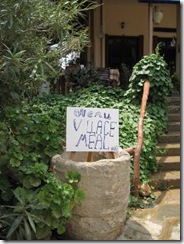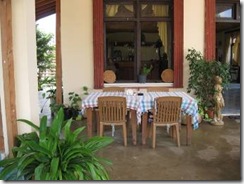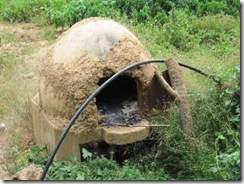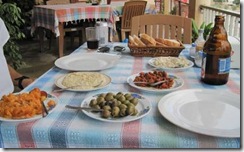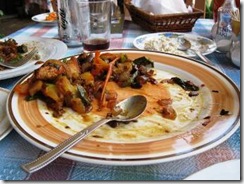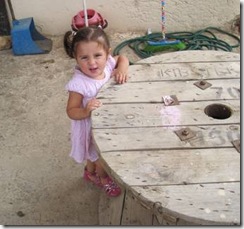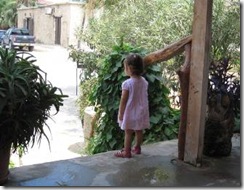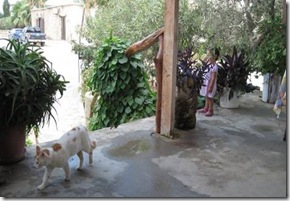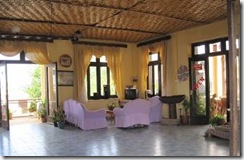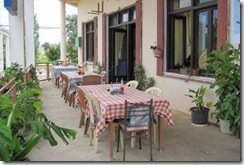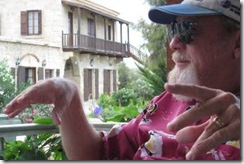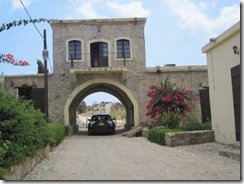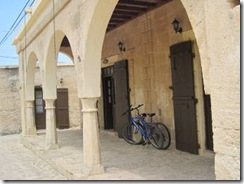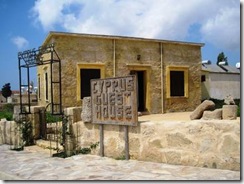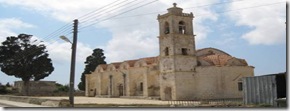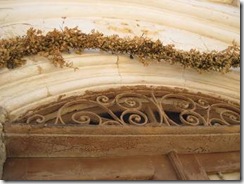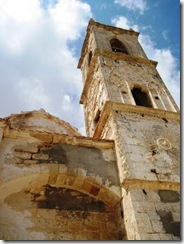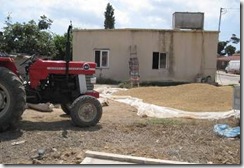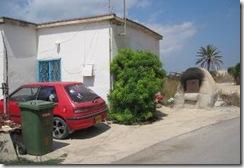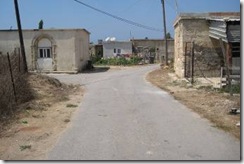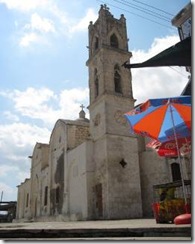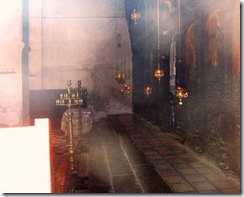Everyday a new adventure. What I especially going to love about this marina is that I can walk out and into the countryside in about 5 minutes. Absolutely zero excuses not to get out the watercolor travel kit and paint. Friday was the motorbike trip east along the Peninsular, Saturday I walked to some ancient ruins in the morning and through fields along the coast at dusk with Randal. Today we took a short motorbike ride west, had a wonderful (too large) lunch, came across a lovely ancient church, took a new highway that wasn’t really open yet, and stopped at a local small market where we bought eggs, bread, Coke Zero and a 9 TL ($5) bottle of white wine to have with Randal’s tuna for dinner. Good wine; good fish.
At lunch which I mention below, we met two British couples who are neighbors in England and also neighbors here on North Cyprus where each couple owns a second home. They’ve owned the North Cyprus homes for the past 7 years. One of the women started the conversation by explaining that they weren’t staring at us eating, they were staring at our food! We did have quite a bit. They had just stopped for something to drink as they were short on time at that moment. We gave them a card to our website so they can keep up with us. So that’s it!
Interestingly, here no one seems to understand my Turkish or expect me to speak it either. I said “Hesap Lutfen” at lunch today and the waitress had no clue. I explained somehow that we wanted to pay our bill. I asked her what to say when we wanted to pay and she said, “bill,” which no one had understood in Turkey.
Ru
Dipkarpaz Lunch
We left the Apostolos Andreas Monastery and headed back along the Karpaz Peninsula looking for lunch. There are about a dozen small hotel/restaurants but most looked deserted and a few, not so appealing (though we don’t really know and the food could have been great.) We did finally stop at one just short of the park exit which looked very appealing especially with the fleet of small fishing boats tied up at the small wharf. Alas, only breakfast and dinner are served. At that point we decided to head back to the small town of Dipkarpaz and the Arch Houses Hotel and Restaurant which we had seen when we’d taken the wrong road in earlier that morning. When we got to Dipkarpaz Arch Houses seemed not opened so we ate in Manolyam across the street. As we drove into the parking lot so did another couple with two young children and a baby. We smiled at them and later found out they were the restaurant owners! Lucky timing for us!
The sign at the foot of the steps…and the outdoor seating.
There was seating on two sides of the building and it appeared as if seating is available on the roof as well. As we were the only ones there at the time we took a small table on the patio off to the side to watch the nonexistent traffic go by.
The restaurant’s stone oven.
The oven is used for bread and to make one special meal the name of which I didn’t catch when the owner explained it to us. It takes three hours to heat the oven and then you have 3 hours available for cooking with the retained heat. Most homes have them and we saw some for sale in a shop in Yeni Erenkoy.
We ordered the Village Meal…; enough for a village!
First came the 5 meze dishes and bread…..then salad….then our chicken dish…..
The meze included all different tastes, degrees of spiciness, and textures; some creamy, some lumpy and all different colors. We were given a basket of bread but then our young waiter took it away saying “mistake.” We soon noticed the restaurant owner walking away and then back with a bag of bread. Maybe he thought our bread hadn’t been fresh enough though Randal had already eaten a piece and had no complaints. Earlier, our waiter had gone next door to a small market to buy the Coke light I had ordered. Luckily he had thought to get 2 cans since I needed a second one. I don’t always drink enough when we motorbike so I was especially thirsty. Randal had his usual bottle of Efes.
We were pretty full of meze when our chicken dish came: almost forgot to take a photo. The dish had eggplant, onions, peppers, tomato and chicken sautéed in olive oil and spices. Too much food! And the problem is that it’s all so good that we eat it…and I hate to waste it too.
Our entertainment was the owner’s 18 month old daughter.
She would come over and look at us for a bit and smile and then walk off; but never off the patio.
The cat always stayed several steps ahead of her.
The interior….Bob Marley music was playing when we ate our lunch.
It looked exactly as it was supposed to look.
While Randal sat finishing his beer, I went off to take photos of the Karpaz Arch Houses (its main building across the way behind Randal’s hand) and the neighborhood.
Just across the way and around the side road were stone buildings that make up the Arches House Hotel.
I read that you could rent mountain bikes so these folks obviously had done just that.
Another stone building in which to spend the night, Cyprus Guest House.
Now some info about Dipkarpaz…….
“Dipkarpaz (Greek: Rizokarpaso) is a town on the Karpass Peninsula in Famagusta district, north-eastern Cyprus. It is partly located in the ancient city of Karpasia, founded by King Pygmalion.
Dipkarpaz is the biggest town on the peninsula. Soil near the town is very fertile. Local crops include carob, cotton, tobacco, and grain. A tobacco-factory operates in the town.
In 1974, the peninsula was cut off by Turkish troops, and this prevented the town’s Greek-Cypriot inhabitants from fleeing to the unoccupied South. As a result, Dipkarpaz is the home of the biggest Greek-speaking population in the North.
The town has two churches: St. Synesios and the church of the Holy Trinity. They are examples of the typical Cypriot mixed style, combining features of the late Gothic introduced by the Lusignans with the late Byzantine style of the Orthodox tradition. When the island’s Orthodox bishops were banished by the Lusignans in 1222, the Bishop of Famagusta was sent to Dipkarpaz and continued his work in St. Synesios, the main Orthodox Church in the region.
Dipkarpaz is the main settlement, and is the gateway to some of the area’s most interesting ruins. The town is the home to North Cyprus’s largest community of Greek Cypriots, who chose to remain with their Turkish Cypriot neighbours after 1974, and their whitewashed Orthodox church (St.Synesios) rubs shoulders with the mosque overlooking the main square."
http://www.whatson-northcyprus.com/towns/dipkarpaz.htm
Same info but a different slant…..
"Dipkarpaz | North Cyprus
This village is the centre of the Karpaz peninsula, it is here that a mixed community lives side by side just as they have done for hundreds of years. When the island divided in 1974 the majority of people residing in this area chose to stay put. There are Greek Cypriots and Turkish Cypriots, and a mix of Anatolian farmers from mainland Turkey, carrying on their age-old way of life that mostly revolves around agriculture. For them, the political strife was something they preferred not to get involved with. They continue to farm and bring up their families, in a way of life that stays resolutely stuck in a time warp. Admittedly there are more tractors than there were ten years ago, a fact that is very evident at lunchtime when they are all parked outside the coffee shops, but they are the only clue that there is movement towards the 21st Century.
There is the mosque that caters to the spiritual needs of the Muslim inhabitants, and the church of Ayios Synesios does likewise for the Orthodox believers. The mosque is a late 20th century construction, whereas the church was built in the 14th century and enlarged in the 18th.
During Lusignan rule 13th – 15th centuries, Dipkarpaz was one of the twelve main provinces of Cyprus and very wealthy. In the 19th century mulberry trees were grown here to support the prolific silk industry, and today a majority of the vegetables and cereals that are needed on the island come from the surrounding villages." http://www.northcyprus.co.uk/dipkarpaz/ (website of a transplanted Brit who is now a Karpaz booster.)
It’s hard finding out much information about the area other than real estate ads or “what’s happening” kind of information. Internet searching is frustrating with several sites seeming more propaganda about Greek or Turkish rightness. (Our RCPL magazine database wasn’t much help either.) At lunch today, Sunday, a Brit who now lives here said there were more differences between the mainland Turks transplanted to Cypress and the Turkish Cypriots than between the local Greek and Turkish Cypriots. Nothing is visible as it was in Tibet with Chinese soldiers and their armed patrols. If we visit the Green Line at some point we will see UN troops and I’ll think of our friend from Isparta who was a UN Peacekeeper.
The Church of the Holy Trinity about a block away from our restaurant.
It looked pretty abandoned and was locked with a padlock.
A dried wreath of some kind around one of the doorways.
A Massey Ferguson Tractor and some harvested grain.
A stone oven for home use; most homes have one.
A side street on my way back to the restaurant.
St. Synesios on the main road.
AYIOS SYNESIOS
Town / Village : Rizokarpaso / Dipkarpaz
District : Famagusta
The principal church of the town is dedicated to St Synesios, one of the early bishops, and was during the Middle Ages the cathedral of the Orthodox See. This is a cross in square domed church with cylindrical apse and belfry.
The church consists of a nave and two side aisles. The east end of the church probably dates from the 12th century. The southern apse was destroyed when the belfry was built, but the two remaining apses still retain their Byzantine arcading on the exterior.
The whole of the western end of the church and the octagonal dome date from the 18th century, when the church was enlarged. Period : 12th century & 18th century.
http://patrimundianorthcyprus.e-monsite.com/rubrique,ayios-synesios,547836.html
The doors were padlocked shut and the church looked quite neglected, but through the window I got this image and it looks like the hanging lamps are lit. There are paintings behind the hanging lanterns.
While searching for information about our restaurant and Dipkarpaz in general, I came across this bit of “opinion.” The website actually is quite interesting though too sarcastic and at times, mean for my taste.
“On the way back to Dipkarpaz, we pass the €15 million-marina that is being built near Yenierenköy. Excavators and cranes are busy doing their work in the concrete-lined construction site filled with increasingly polluted sea water, where soon overly tan, flabby rich white-haired f***s will park their million-$ yachts in the 500 berths available, hop on the convenient shuttle buses to the soon-to-be-built luxury resorts to indulge in the "full range of five-star services on offer". On the Karpaz Bay Marina-website, it says that "The nearby village will offer a lovely contrast to the modern resort, creating an unforgettable experience for visitors. Every detail will be taken care of, leaving you free to enjoy the sea, the beaches and the beauty of the unspoilt landscape." I wonder how those villagers feel to be reduced to a freak spectacle for affluent Westerners wanting to get a break from their all-inclusive round-the-clock pampering and see the poor conditions those locals live in to make themselves feel superior. It’s also more than ironic that the unique and beautiful Karpas Peninsula, this last relatively unspoilt part of Cyprus, will forever be changed by bulldozers and cement, to then be tainted by the influx of sybaritic, gluttonous boat imperialists, seeking infinite hyperabundant pleasures in an elusive "unspoilt landscape" that doesn’t exist anymore thanks to their contribution. http://www.travelblog.org/Middle-East/Cyprus/Famagusta/Karpass-Peninsula-/blog-616159.html
It was one of those times that I was so stunned that I just had to laugh. I did email Jen asking if he’d actually ever met someone who lives on a boat. But if you’d like to leave a comment on his page, I think it would be nice.

